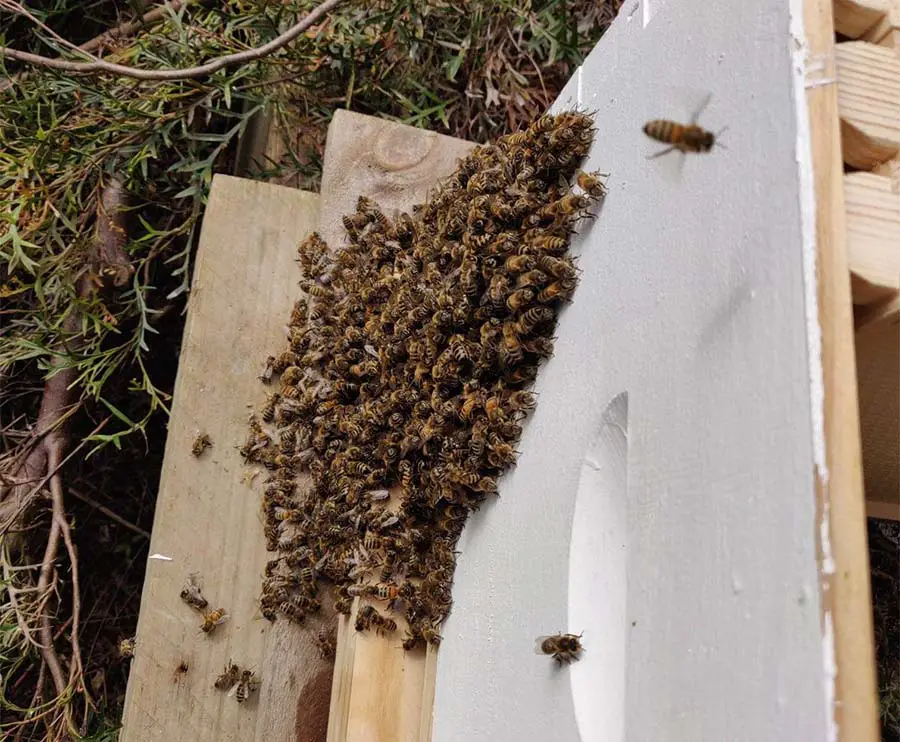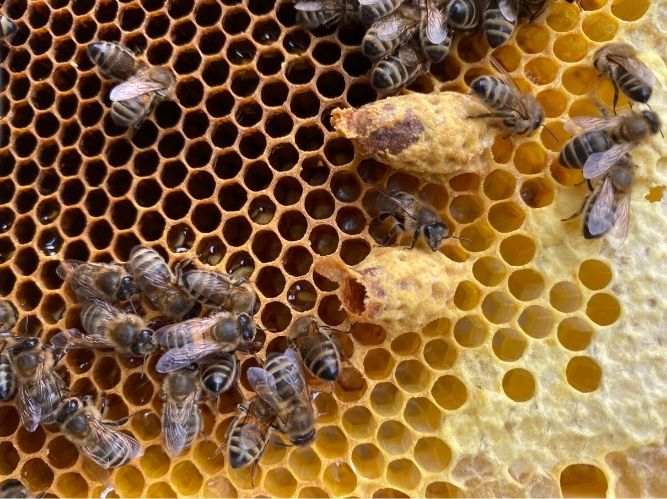Washboarding is a behavior where honey bees sway back and forth in a rocking motion, moving their mouths, antennae and front legs over the surface of the hive. It’s called washboarding because the movement looks almost as if the bees are scrubbing clothes on a washboard.
Bees washboard both inside and outside the hive. While there are a few theories as to why bees washboard, no one really knows for sure.
The video above includes a clip of bees washboarding if you’d like to see what this behavior looks like.
Why Do Bees Washboard?
Although some researchers have investigated bees washboarding to try and determine why it happens, the exact reason is still unknown. However, those who have observed bees washboarding have developed theories due to the patterns in behavior.
Norman Gary, a former professor UC Davis Department of Entomology, who has kept bees for more than sixty years, suggests that washboarding is done to clean the hive. The rocking back and forth movement, during which bees make contact with the surface with their mouths, is a way to scrape and polish the hive.
In H. Storch’s book ‘At The Hive Entrance’, the author noted that washboarding was more common among colonies who were harvesting large amounts of pollen. After viewing bees through a magnifying glass, he concluded that bees washboard to remove tiny pollen grains from their bodies, because the pollen often slides into the gap between the head and the thorax and causes discomfort.
Further Research Into Why Bees Washboard
There have been a couple of noteworthy studies into bees washboarding to try and determine why the behavior occurs. One such study was conducted by Katie Bohrer and Jeffery S. Pettis in the USDA-ARD Bee Research Laboratory. They made the following observations:
- Washboarding bees are always worker bees
- Washboarding starts around 8 am, with more bees joining the activity as the day progresses. The number of bees washboarding typically peaks about 2 pm and continues as late as 9 pm after the sun has set
- There seems to be a correlation between bees washboarding and age. The majority of the bees washboarding are adolescent bees aged between 15-25 days old
- When given the choice of surfaces, bees washboard more on textures with rough surfaces (though it’s also stated that more research needs to be conducted to make any certain conclusions)
Another researcher, James F. Taulman, published an article after observing washboarding in honeybee hives found in cavities of dead trees in Douglas County, Kansas. His observations led to his belief that:
- It is probable that washboarding plays some role in cleaning the hive
- In addition, it’s likely that a major reason bees washboard is to spread pheromones from workers’ tarsal and Nasonov glands to help other bees find the hive entrance. The head-down position of washboarding may help bees to disperse the volatile Nasonov pheromone.
Bees Bearding Vs Bees Washboarding
Washboarding and bearding often occur on the front of a hive, which is why many people confuse the two. However, washboarding and bearding are completely different behaviors.
Bearding is when bees cluster together outside the front of the hive in shape that looks like a beard. Bees beard to regulate the internal temperature and humidity of the hive. Bearding typically occurs at night during hot weather, once bees return to the hive after foraging for pollen and nectar.
A hive that is too hot is dangerous for bees. Extreme temperatures can cause the brood to die, threatening the existence of the colony.
Further, if the hive is too humid, it makes it difficult for bees to reduce the moisture content of nectar and make honey – which is also essential for the colony’s survival.
Washboarding, on the other hand, occurs at all times of the day, generally starting at 8am and peaking at around 2 pm. Unlike bees that are bearding, washboarding bees do not cluster, but maintain a small distance in between each other. This gives them enough room to rock back and forth.
Discover other strange bee behaviors here.

Bees Washboarding Vs Bees Swarming
Because bees that are about to swarm can sometimes cluster outside the hive, it can also be mistaken with washboarding. However, swarming and washboarding are two completely different behaviors, and there is no known link between the two.
If you see a large group of bees on the outside of your hive that are rocking back and forth, they are almost certainly washboarding – not preparing to swarm. However, if you’re still worried, you can simply conduct a quick inspection of your hive to make sure.
Swarming typically occurs as a natural means of reproduction. When there is no more room inside the hive, half the colony will leave, along with the queen, to start a new one. So, if you’re concerned your bees are about to swarm, check to see how much space they have left.
If all frames are completely filled with comb, especially if the comb cells are full of honey and brood, your colony needs more room – so you should either add more frames, another brood box or honey super, or split the hive to stop the colony from swarming.
Before swarming, bees also raise a new queen to take over the old hive once they’ve left. So, during your inspection, you should also look for queen cells. These are long, vertical cylinders that can usually be found on the bottom or outer edges of the comb. The presence of queen cells is another sign your bees could be preparing to swarm.

Conclusion
No one really knows for sure why bees washboard. Despite some research, the peculiar behavior of rocking back and forth while moving their mouths and antennae across the surface remains somewhat of a mystery.
The majority of experts believe that it is done for one, or more of the following reasons:
- To clean the hive
- To spread pheromones in order to help other bees find the hive entrance
- To remove tiny grains of pollen from their bodies
In addition to this, we also know that:
- Bees that washboard are always workers
- The activity usually starts in the morning and increases in the afternoon, continuing as late as 9pm
- Most bees washboarding are aged 15-25 days
